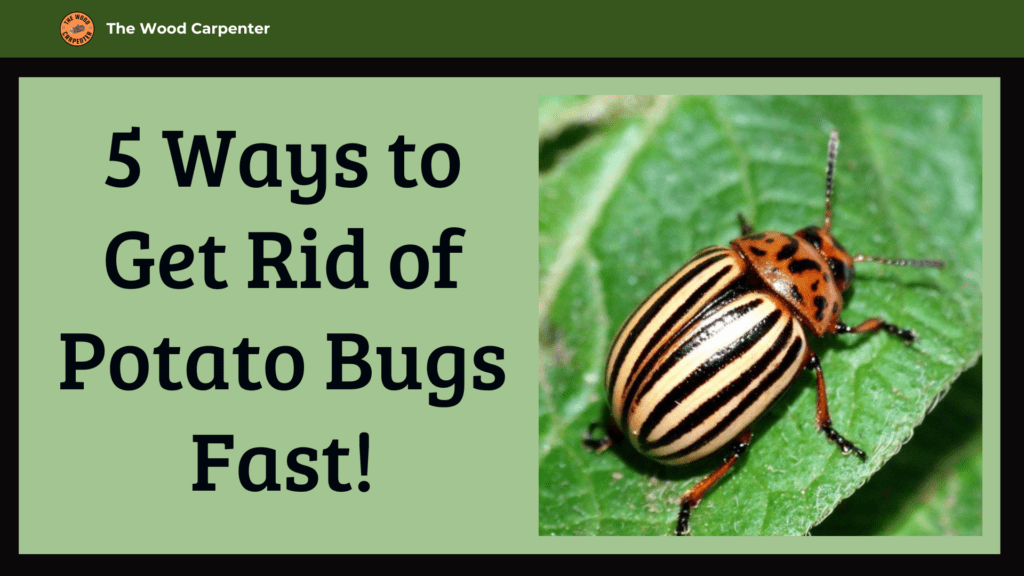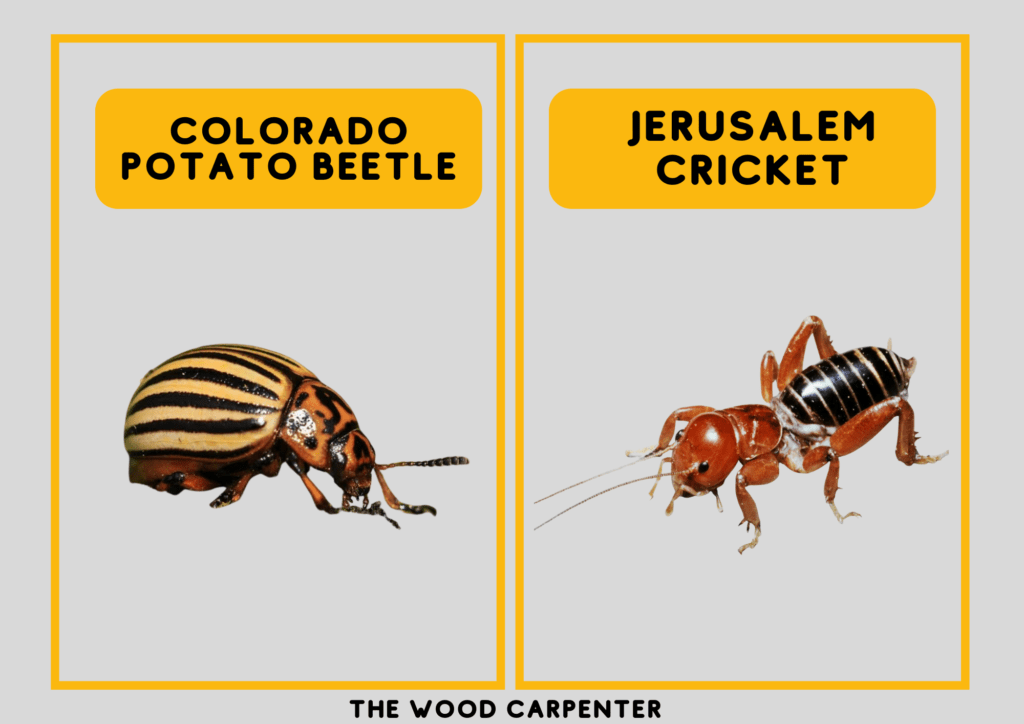
If you’ve ever heard the term potato bug, you might picture a creepy insect crawling around your garden or maybe even imagine it munching on potatoes. But here’s the twist – “potato bug” is actually a reference to two very distinct creatures, depending on who you ask.
Some will say “Colorado Potato Beetle” (a very destructive potato crop pest) some use “Jerusalem Cricket” to describe a strange little critter with a bald head and chunky body that is harmless in the garden.
So, what’s the real story? Let’s dig in.
Types of Potato Bugs
Before you reach for any sprays or powders, you need to know which “potato bug” you’re dealing with.
1. Colorado Potato Beetle (Leptinotarsa decemlineata)
What it looks like: Small, rounded beetle with bright yellow-orange body and bold black stripes.
Why it’s a problem: This is the true potato pest. Both adults and larvae eat potato, tomato, and eggplant leaves, stripping plants down fast.
Where it’s found: Across North America, Europe, and even Asia.
2. Jerusalem Cricket (Stenopelmatidae family)
What it looks like: A big, wingless insect with a bald, humanoid-looking head, chunky body, and orange-black banded abdomen.
Why it’s misunderstood: They rarely eat crops. Instead, they munch on decaying matter and help the soil. But they can bite if handled.
Where it’s found: Western U.S., Mexico, and Central America.
👉 Bottom line: If your potato plants are suffering, it’s almost always the Colorado potato beetle. Jerusalem crickets might look scary, but they’re not out to ruin your harvest.

The Strange World of Jerusalem Crickets
Jerusalem crickets tend to cause most people discomfort. Their shiny orange abdomens with black bands are especially unnerving, while their large heads and strong jaws seem straight out of a science fiction movie.
One evening in summer I remember flipping over a garden steppingstone and finding one staring back. Its spiny legs kicked wildly while making a faint drumming sound against the soil – startling me more than necessary but once I learned more I realized they’re often misunderstood.
Here’s the truth:
Not poisonous. While they can bite if handled roughly, they won’t inject venom; at worst you may feel an uncomfortable pinch.
They serve as invaluable recyclers, feeding off of decaying plant matter, dead roots and even insect carcasses in order to enrich the soil with every bit of decayed matter they devour – enriching it along the way!
Shy by nature, these animals prefer staying underground rather than engaging with humans and sunlight.
Males use an unusual mating call; males “drum” their abdomens on the ground to attract females. After mating, however, females sometimes eat their partners–nature can be cruel!
Though their alien appearance gives them a reputation of frightening visitors to your garden, these strange beasts should really be taken as harmless garden peculiarities rather than enemies to fear.
The Real Pest: Colorado Potato Beetles
If you’re a gardener, the real “potato bug problem” is the Colorado potato beetle. These little striped beetles can wipe out potato plants if left unchecked.
What they look like: Bright orange to yellow beetles with black stripes running down their wing covers.
What they eat: Potato leaves, but also tomatoes, peppers, and eggplants.
Why they’re a problem: Both the adults and larvae devour foliage, stunting plant growth and reducing yields.
Once established, they multiply quickly and are notoriously resistant to pesticides. That’s why organic gardeners often rely on a mix of hands-on methods and natural barriers.
5 Ways to Get Rid of Potato Bugs Fast
Now let’s get practical: If Colorado potato beetles have invaded your potato patch, here is how you can quickly and naturally fight back against their invasion.
For Colorado Potato Beetles
1. Hand-Picking Is Effective
Grabbing beetles off plants and tossing them into a bucket with soapy water is one of the fastest and cheapest ways to control Colorado Potato Beetle populations in smaller gardens.
2. Diatomaceous Earth Dusting
Spread food-grade diatomaceous earth onto potato leaves for dusting purposes. Beetles hate crawling over it as it cuts into their exoskeletons – to get maximum impactful coverage apply after rainfall or dewfall so it sticks securely – it’s nontoxic to people and pets but will kill off pests quickly!
3. Crop Rotation
When planting potatoes each year, switch planting spots regularly in order to confuse beetles and prevent their breeding cycles from continuing unchecked. If heavy infestations have been a problem for you, rotating planting locations is an easy and fast way to bring down populations quickly.
4. Neem Oil Spray
Neem oil is a natural pesticide that disrupts beetle feeding and egg-laying. Spray it directly on leaves and larvae. It’s especially helpful if hand-picking isn’t enough.
5. Mulching and Raised Beds
Colorado potato beetles often overwinter in soil. By adding thick straw mulch or using raised beds, you create a less welcoming environment. Bonus: it keeps the soil moist and helps your potato plants thrive.
Also read:
7 Proven Carpenter Ant Killers That Will Save Your Home
What to Know About Black Carpet Beetles: Identification, Damage, and Control
For Jerusalem Crickets
Usually, no control is necessary.
If you find one indoors, scoop it up in a container and release it outside.
To reduce encounters further, tidy damp areas, remove piles of wood or rocks and seal entry points in your home to reduce encounters with these insects.
Always keep in mind: Jerusalem crickets tend to be more friendly than destructive, while Colorado potato beetles require special consideration.
Do Potato Bugs Bite Humans?
This is perhaps the most frequently asked question regarding Jerusalem crickets, which may bite when provoked but are nonvenomous; their bite may feel similar to being pinched strongly and leave a small mark, although any irritation should be immediately cleaned off the affected area in order to avoid infection.
Colorado potato beetles – While reports of giant, toxic “potato bugs” terrorizing humans might sound frightening, most such claims are falsehoods.
Why Potato Bugs Matter in the Ecosystem
Jerusalem crickets play an important role as the decomposers. They help to recycle nutrients back into the soil. They’re also food for owls, foxes, skunks, and other wildlife.
Colorado potato beetles, on the other hand, remind us of the delicate balance in agriculture. Their spread shows how a single pest can challenge farmers worldwide.
FAQs About Potato Bugs
1. Are potato bugs dangerous?
No. Jerusalem crickets can bite, but they aren’t poisonous. Colorado potato beetles don’t bite humans at all, though they are dangerous to crops.
2. Why are they called potato bugs?
Jerusalem crickets got the nickname mistakenly, while Colorado potato beetles earned it because they really do attack the potato plants.
3. Where can potato bugs be found?
Jerusalem crickets can be found throughout Western United States, Mexico and Central America.
Colorado potato beetles: Widespread across North America and now spreading into Europe and Asia due to crop distribution.
4. How can I keep potato bugs away from my garden?
For Colorado potato beetles, try handpicking, diatomaceous earth application, crop rotation and handing-picking while for Jerusalem crickets simple relocation and yard cleanup may do the trick.
5. Do potato bugs come indoors?
Rarely. Jerusalem crickets may wander inside by accident, but they don’t infest homes.
6. What do potato bugs eat?
It depends on the type of the potato bug. The Colorado potato beetle feeds on potato leaves and other plants in the nightshade family, like tomatoes, eggplants, and peppers. The Jerusalem cricket, on the other hand, mostly eats decaying plant matter, roots, tubers, and sometimes the small insects.
Final Thoughts
Under the name “potato bug,” a tale of mistaken identity is enacted. One of them (the Jerusalem cricket) is the misunderstood and beneficial soil dweller in your garden. The other (the Colorado potato beetle) poses a real threat to crops and requires aggressive control.
Next time you hear someone screaming about a creepy “potato bug,” you’ll also know exactly which one they’re shrieking about — and whether it’s a creature to fear or just respect.

